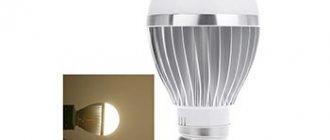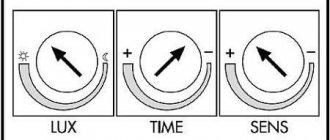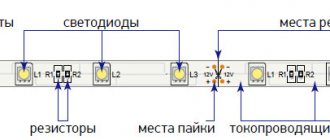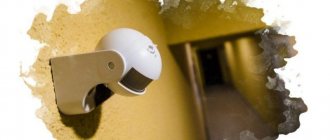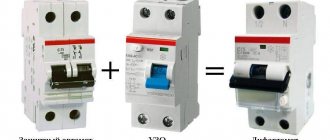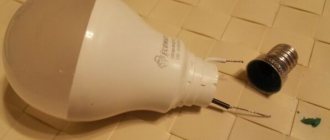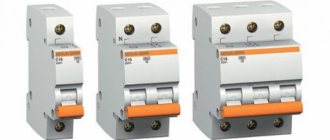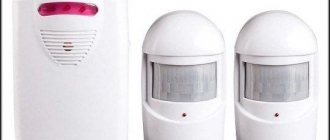A few years ago, battery-powered motion sensor lights were a rarity.
But over time, their number has increased noticeably , which is why a person now has a large selection in the store.
And consultants try to sell the model that is more expensive - after all, that’s their job.
Therefore, we decided to compile a rating and review of battery-powered motion sensor lamps to make it easier for you to choose the right model.
Purpose of the motion sensor
The sensor element is charged with the function of determining the fact of movement of any object within reach and controlling the lighting. The lamp itself has nothing to do with responding to certain circumstances, but after receiving a signal from the sensor, it turns on or off.
As soon as some action is detected in the coverage area, a preset function on the relay is activated. Not only the “turn on” command can be given, but also a signal to change a parameter such as power. For a light bulb with a motion sensor and a dimmer, it is possible to adjust the light levels according to the time of day.
The interaction of the sensor, dimmer and lamp, as well as the time delay for turning on, depend on the previously programmed system settings. The last action is the activation of a command to activate the lamp after a set period of time, as a result of which it becomes possible to save energy.
Lamps supplemented with a built-in motion sensor are most often installed in residential premises, offices, and entrances. They are also used for smart outdoor lighting.
A lamp with a motion sensor is the best option for lighting in the entrance. It will only turn on when a person appears in the front door or on the staircase
A person, due to his characteristic inattention, can leave the light on, and this results in additional expenses. A light that turns on after the room is empty simply solves this problem.
Lamp designs
The design of devices is closely related to their purpose. Street lamps are used for outdoor lighting, standard lamps are used for indoor lighting, and spotlights can be used in both. In addition to being located at security facilities, LED floodlights are used to illuminate architectural structures, advertising signs, etc.
LED lamps are an excellent alternative to fluorescent and filament products.
There are more “exotic” designs. For example, you can buy a socket with a built-in motion sensor, which is installed in any lighting device instead of a standard one or screwed into the latter like a regular electric lamp (serves as an adapter).
Types of lamps with motion detector
Depending on how the energy carrier is used, lamps can be:
- Stationary . They only function when connected to the network. They cannot be installed anywhere.
- Portable . These are self-contained devices that run on replaceable batteries. The advantage is that there is no connection with wires, but there is a power limitation.
Not only the traditional power grid can be used as an energy supplier. There are lamps equipped with solar batteries and a rechargeable battery. Only LED lamps can work with such power supply, because... they need a minimum of electricity.
According to the connection method, there are two options: in the first of them, the motion sensor is connected to the lamp using a wire and is called remote.
Led lamp equipped with a DD type sensor. Battery operated. Thanks to its portability, it can be used anywhere
In the second, the sensor element and the lamp are a single structure; the sensor in this case is called built-in. The reading element can be either infrared or ultrasonic, based on microwave radiation.
Lamp with infrared detector
The most popular are devices supplemented with infrared detectors. They are activated when thermal characteristics change in the control zone. Such IR sensors are classified as passive. These devices have a large capture angle, high-precision settings, and safe radiation.
Lamps equipped with motion sensors are an excellent and competent solution for both modern lighting of homes, outbuildings, stairs, local areas, and for use on a large scale
Lamps with passive IR detectors are intended for indoor use only. Their use for lighting courtyards and streets is impossible due to poor resistance to temperature changes. They take them out of action.
Ultrasonic and microwave options
These types of motion sensors are classified as active based on their operating principle. They have a common operating principle - emitting and receiving waves of a specific length. Lamps with sensors that respond to ultrasonic frequencies are universal. They are not afraid of atmospheric influences, so they are suitable for installation both inside and outside the house.
But ultrasonic sensors have disadvantages, and the main one is the negative impact on animals that can detect radiation. Added to this is a limited coverage area and low accuracy.
Microwave-based sensors operate by propagating magnetoelectric waves at frequencies greater than 5 GHz. They equip lamps installed in utility and industrial premises. Here their action is designed to pass through partitions and walls.
Expensive lamp models with motion-sensitive sensors are equipped with control panels. Their design includes several reading devices that control and, to some extent, overlap each other’s zones of influence.
A new generation lamp with two motion sensors - IR and ultrasonic. At the moment of their simultaneous operation, the lamp turns on
Lamps with sensors are designed to be powered from a source generating alternating current with a voltage of 220 V. The maximum power is up to 2 kW, although there are devices operating from 12 V.
Location of lamps on the ceiling
Regardless of the presence or absence of a motion sensor, the lamps on the ceiling are placed as evenly as possible for high-quality and efficient lighting of the entire room. Do not forget that the main purpose of the lamp is to emit light. First, calculate the required number of lamps installed on the ceiling.
The following standards exist for LEDs:
- For a comfortable stay in the living room of 1 sq. m must be at least 3 W.
- In the bathroom and bedroom - 2 W/sq. m (no longer needed).
- Lesser requirements apply to the hallway - 1 W/sq. m.
- The children's room has a play area and a place where your child will do homework, so the light level here is high - 8 W per 1 sq. m. m. In this case, you need to add a dimmer and separate switches for partial or full lighting, depending on the child’s needs.
Depending on the specific room, the direct location of the lamps will be individual. In the bathroom, spotlights are placed around the entire perimeter at the same distance to avoid the formation of areas with low lighting.
In the living room, in addition to the chandelier located in the center of the ceiling, it is advisable to place spotlights along the long walls, providing dim light when the main source is turned off. The lighting in the bedroom is almost the same as in the living room, except for the choice of a less bright chandelier. An excellent option would be to use a dimmer to adjust the brightness of a table lamp and sconce.
In a children's room, place lamps evenly around the perimeter of the room. Increase their density (number) in work areas - play and study areas. Do the same in the kitchen with the food preparation area.
If there are wall cabinets, then pay attention to the following: move the location of the lamps away from the edge of the cabinet 15–20 cm closer to the center of the room.
Lamp design features
The difference between a light bulb with a motion sensor and the most ordinary one is the presence of a responsive element. The shell is made in the form of a lantern, floor lamp, chandelier or shade. Paired with a motion detector, different types of lamps are used: LED, fluorescent, halogen.
The most successful is a tandem with an LED lamp. These functional devices are compact and easy to install. LED models are sometimes additionally equipped with an independent control relay or controller. Thanks to the presence of these options, you can control both the brightness and glow parameters.
The photo shows a lamp with a Lemanso lm650 motion sensor. The device is used to illuminate any room. Installation is extremely simple—similar to screwing in a regular light bulb
In some cases, protective systems are included in the circuit to protect against short circuits, temperature overloads, and high voltages. Regardless of the internal configuration, the operating principle of such lamps is unchanged: the lighting device must have a reading element - a sensor.
Advantages and disadvantages of lamps with motion detectors
A lamp with an electronic eye has many advantages. These devices are very convenient - when the system switches to automatic mode, there is no need for manual control.
Another advantage is the versatility of the lamps. They can be equipped with any type of light element, from a simple incandescent lamp to the most modern and economical light bulb.
Manufacturers produce these devices in a wide range of sizes. Since they only work periodically, they have a long service life. Lamps can be very decorative, so they are often used in landscaping.
High-quality luminaires with motion detection have mechanical and electronic adjustment levels. In the first case, we mean the angle of inclination, and in the second - the glow time, the sensitivity of the sensor
An alarm system can be connected to a lamp with a motion sensor. Such an alliance will help protect the yard from robbers. A good solution is a lamp with a beam configured according to all the rules and placed above the front door or in a dark garage. But the main advantage is considered to be the efficiency of these lighting devices. They save from 50 to 70% of electricity.
The disadvantages include two features of such lamps. The first is that the sensor is not able to detect movement that is perpendicular to it. Secondly, such a device is of little use for a room where people stay for a long time.
Features of lamp installation
To connect a lamp supplemented with a sensor, all circuits used for a simple motion detector are suitable. There are three types of such schemes.
The first is a parallel connection of the device with a switch. In this situation, the lighting is turned on both due to the detection of a moving object in the controlled area, and through a switch.
The second is a serial connection of the sensor and switch. With this type of connection, the lamp can function only after closing the circuit by turning on the switch.
The third is a combined connection. After detecting movement in the controlled area, additional lighting is activated using a sensor.
These connection diagrams are the simplest. To prevent the sensor from triggering during the daytime, you should purchase a lamp with a motion sensor, supplemented with a light intensity sensor
The position of the switch has no effect on this. The main lighting source is turned on by a switch.
Installation of a lighting device with a motion sensor
Let's consider the process using the example of a lamp intended for indoor installation. Due to its design, it is suitable for both ceiling and wall mounting. The housing contains a regular lamp, an ultrasonic HF motion sensor, and a light sensor.
The installation technology is simple and consists of six steps:
- At the first stage, the device is prepared for installation. The kit usually includes rubber seals. They are inserted into special holes designed for cable entry.
- De-energize the installation site by turning off the circuit breaker on the panel.
- The power cable is pulled through the seal into the lamp body. If there is excess length, shorten it.
- The housing is secured to the wall or ceiling through the holes provided for fastening.
- Remove the braid from the power cable. If the housing material is dielectric, grounding is not required. Only the “zero” and “phase” wires are used, having previously removed the insulation from their ends - about 7 mm.
- Connect the wires to the appropriate terminals and secure them using a screwdriver. The phase wire is inserted into terminal L, and the neutral wire into terminal N.
The blank terminal, indicated by the symbol L with a prime, will remain unused. It is control and can be used to connect other lamps, ventilation or other equipment.
Phase conductors are the most dangerous when working with wiring. Most likely, for this reason they have the brightest color. In the diagrams they are indicated by the symbol L. When there are several phases, a number is added to the letter
The only limitation is the power consumed by these devices. It should not exceed the additional connected load specified in the passport.
To determine which wire is phase, neutral and ground, you need to be able to read the color markings. Both here and in Europe there is one standard - IEC 60446 2004 .
According to this document, the color blue, or sometimes blue-white, indicates working zero. The ground wire is yellow-green in color. To mark the phase, the remaining colors are used - brown, black, red, white, and others.
If there is old wiring, the colors may not match the standard. Here, to determine whether they belong to a specific type, you will have to use a digital multimeter, an indicator screwdriver or a test light.
Connecting a lamp with a remote sensor
Installing a light bulb with a remote motion sensor has its own characteristics.
First, install the detector:
- Determine the installation location that provides the best viewing angle.
- The stand, previously removed from the device, is attached to the wall at a height of at least 240 cm.
- Clean the ends of the voltage wires connected to the sensor by removing about 1 cm of insulation from them.
- Open the cover of the sensor terminal box. There are multi-colored wires inside it.
- 220 V is supplied to the sensor by connecting the neutral and phase wires to the voltage.
Finally, the connection points are isolated. Next, proceed to connecting the light bulb and sensor. A phase is connected to one end of the lamp and insulated. The other end is connected to the neutral wire.
The blue wire is neutral, usually in diagrams it is designated by the letter N. The phase wire is red-brown in color and marked with the symbol L. The ground wire is yellow-green (⊥)
If the phasing is accidentally reversed during the connection process, the device will not work, but will remain in working condition. You just need to swap the wires. Using the same algorithm, it is possible to connect a wire with a plug to the detector.
The sensor itself is very easy to operate.
There are three regulators on its body that allow you to change the factory settings:
- SENS - sensor. It is used to set the sensitivity of the sensor. Such parameters are experimentally selected so that the device does not react to small animals.
- TIME — setting the lamp glow time.
- LUX - day-night adjustment. Set it so that the lamp turns on at dusk.
The response time can be adjusted in the range of 0.05 – 15 min. The sensor works most effectively at a capture angle of 120 to 360 degrees, over an area of about 20 m.
Lighting devices with sensors are turned on or switched to a special operating mode, both using special and ordinary switches
When determining the height and angle of inclination, it should be taken into account that some infrared sensors may have a dead zone. If the device has a fixed body and there is no positioning correction, it must be placed in accordance with the technical data sheet.
Recommendations from experts regarding installation
Experts do not recommend installing lamps with motion sensors in corners. The reason is a reduction in the viewing area.
Malfunctions and false alarms can also occur if such a lighting device is installed near air conditioners, radiators, and heat fans. Sometimes the lamp can turn on even when the blades of a room fan rotate, due to branches swaying outside the window.
When installing lamps with sensors within an apartment, experts advise placing them in the center of the ceiling. This is the optimal solution to the problem of detecting an object at the required time and at a specified distance.
Optimal parameters for installing a lamp with a motion sensor on the wall of a house. If they are followed, it will be possible to control the required zone for triggering
Installing lamps with sensors outside involves taking into account individual moments. This is the openness of the panorama, detection angle, cross-country ability, permissible load, distance to enclosing structures. Due to insufficient cross-country ability, several sensors are sometimes installed.
Top best manufacturers of lamps with sensors
One of the first to appear in this segment of the lighting market was a manufacturer from China, Feron . Such models of this brand as AL-559 and FN1200 are known. Their main advantage is a powerful luminous flux.
High-quality LED lamps equipped with motion sensors are produced by the German company Steinel . These are reliable modified models of lamps with infrared motion sensors RS 16L, RS LED D1.
LED lamps with such a sensor, produced by the Polish manufacturer Kanlux, are popular.
A lighting device equipped with a microwave motion sensor. Model TYBIA LED 38W-NW-SE 24641 is designed for indoor installation with a power of 38 W
A company from Germany, Euroelectric, produces excellent lamps with sensors. We know the ST line of lamps from this manufacturer. Thus, model ST-69-2 is a good option for mounting on the wall of a house. It operates in a wide temperature range - from -20 °C to +40.
The Hardt company (Poland) supplies the market with special lamps with sensors for housing and communal services in a moisture- and dust-proof design. Led-Hardt wall lighting fixture , equipped with an LED lamp, is highly impact resistant.
Excellent lamps for lighting home areas, parking lots, and billboards are produced by the manufacturer Delux . Here they produce LED spotlights with motion sensors, both narrow-beam and floodlight, with a degree of protection IP65.
An example of a good all-purpose battery-powered mini lamp is the Mighty Light , released in China. It has a photo sensor and a built-in motion sensor. Equipped with a waterproof housing. The lamp installation method is wireless.
The best expensive lamps with motion sensors
More expensive models are characterized by increased functionality and are almost always adapted to difficult operating conditions.
Steinel L 22
5
★★★★★
editorial assessment
98%
buyers recommend this product
A high quality street lamp will not require much effort during installation. The body of the device has a stylish design that fits beautifully into any environment. The model is reliably protected from mechanical impact and moisture according to the IP44 standard, so it can easily withstand outdoor weather conditions.
The lamp is equipped with an infrared motion sensor, the response zone of which covers 180°, and the range of action reaches 10 meters. The high build quality of the model and the moisture-resistant materials used extend the service life of the device.
Pros:
- Increased sensor range - 10 meters.
- Low power consumption.
- High-quality manufacturing materials.
- Easy to install.
- Stylish, minimalistic design.
Minuses:
- Quite a high price.
The lamp is suitable for those who live in regions with a humid climate. When installed under a canopy, it can work in any weather.
Xiaomi Mi Bedside Lamp EU Gold
4.9
★★★★★
editorial assessment
95%
buyers recommend this product
The night light from Xiaomi has a huge number of different lighting modes: glowing in different colors, turning on and off by timer, simulating a fireplace, candle or sunset.
Control takes place through the proprietary MiHome application or using Google Home, and thanks to the motion sensor, the lamp will turn on itself, saving energy.
The device is compact (the height of the lamp is only 22 centimeters). The body of the night light is made of metal, the shade is made of matte plastic. There are 14 LEDs inside. The lamp is connected to a regular outlet. A touch panel is installed at the top of the model, allowing you to adjust the lighting intensity.
Pros:
- Works with a smart home system.
- Many backlight modes.
- Adjustable brightness.
- Small size.
- Beautiful design is a good addition to the interior of the room.
Minuses:
- It is necessary to purchase an adapter for the socket.
The night light is perfect for those who like to customize the lighting in the room to suit their mood, and thanks to its simple design and compact size, it will fit perfectly into any room.
Eglo 88142 City
4.8
★★★★★
editorial assessment
92%
buyers recommend this product
The Eglo City street lamp has a metal frame with a plastic shade as the basis of its design. The light source here is an ordinary incandescent light bulb. The device is protected from splashes or dust on all sides. There are several more models of lamps of this type in the City line.
The device is characterized by relatively small dimensions (24×27 centimeters). The motion sensor is triggered at a distance of several meters and has a coverage area of 180°. This model does not have brightness adjustment. But the device is reliable, high quality and can last for several years.
Pros:
- Can work with a regular energy saving lamp.
- High build quality.
- Protected from moisture and pollution.
- Small size.
- Easy installation.
Minuses:
- Unregulated light brightness.
A good model from an Austrian manufacturer is suitable for those who need an inexpensive and easy-to-maintain outdoor lamp.
IEK NPO3237D
4.8
★★★★★
editorial assessment
89%
buyers recommend this product
This lamp works with conventional incandescent lamps. The round body of the device is made of aluminum, and the lampshade is made of opal glass. The shape and small diameter make it possible to place the device not only on the wall, but also above the door or even on the ceiling.
Opal glass has a dotted pattern and a matte finish that diffuses light well. The diameter of the lamp is 27 centimeters. It is capable of operating at temperatures from -20 to +45 °C.
The operating range of the infrared motion sensor is about 6 meters, and the automatic shutdown time of the device when there is no one in the covered area is 3 minutes.
The model does not have serious protection from dust or moisture, so it is not recommended to install it outdoors or in damp rooms such as a bathroom, where there is a high risk of moisture getting on the device.
Pros:
- Possibility of placement not only on the wall, but also on the ceiling.
- Good operating temperature range.
- 2 lamps are used as a light source.
- Beautiful opal glass lampshade.
Minuses:
- Low degree of protection against moisture and dust.
The lamp is perfect for placement anywhere in a room or non-residential area with normal air humidity.
READ ALSO
12 best dimmers
In Home SPB-2D-KRUG
4.5
★★★★★
editorial assessment
82%
buyers recommend this product
The wall-ceiling lamp is made of plastic that is resistant to wear and fading. Installing it takes a few minutes, and connecting does not require changing the wiring in the room.
The infrared motion sensor can be adjusted, changing the operating range from 3 to 8 meters. The lighting switch-off time can also be changed: the minimum threshold is 30 seconds, the maximum is 8 minutes.
The lamp can turn on independently depending on the level of ambient light. If you turn the control to the “night” position, it will only respond in low light conditions.
The model has a low level of energy consumption and has an A+ energy efficiency class, since LEDs act as a light source. The device operates at temperatures from +1 to +35 °C and is protected from water and dust.
Pros:
- High energy efficiency.
- Switchable light sensor.
- Easy to connect.
- Adjustable motion sensor range.
Minuses:
- Does not tolerate low temperatures.
- Not very high build quality.
The lamp is well suited for rooms that do not need constant bright light: a basement, utility room, garage or bathroom.
Conclusions and useful video on the topic
A thorough review of the Xiaomi MiJIA night lamp equipped with a motion sensor:
About installation of motion sensors according to all rules. Devices with such sensors are installed according to an identical scheme:
Both manufacturers and specialists, when talking about the advantages of lamps with a motion sensor, place the main emphasis on their efficiency. For them to really be like this, they need to be properly installed and configured. The conditions of use and protection class of the lamp are also important.
If you have experience using lamps with a motion sensor, please tell us which manufacturer's equipment you prefer. Are you satisfied with his work? Leave your comments and ask questions about the topic of the article in the block below.
